Article
The French Connection III: The Mingan Islands' Daughters of the Sea
Author(s):
The Mingan Archipelago is made up of 30 limestone islands with natural monuments carved by the sea and the passage of time.
Photography by the authors

Le Perroquet de Mer
Our ship would appear to have shrunk. We have only 40 passengers aboard but the boat seems fairly full. Maybe that’s because we are not on our swish but on a little exploration boat called , the sea parrot. A French passenger holding up the map for our photograph tells us the sea parrot is the Atlantic Puffin, a seafarer. That’s reassuring for we know parrots can’t swim.
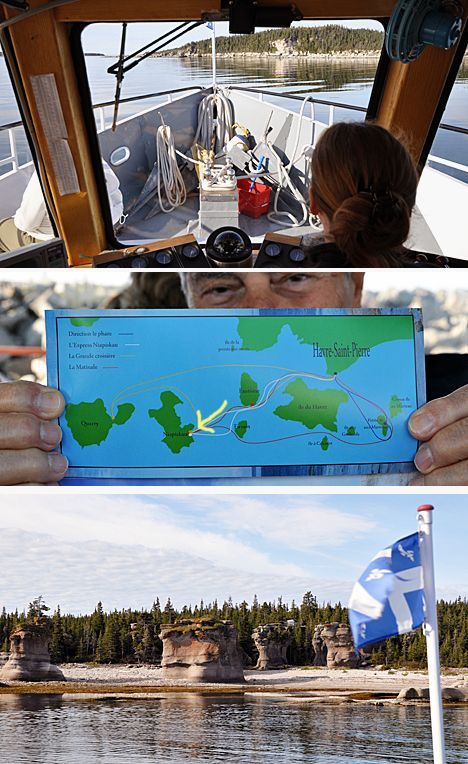
Ahead lays the Mingan Archipelago National Park Reserve of Canada — about 30 limestone islands with natural monuments carved by the sea and the passage of time.
The brochure published by Parks Canada is not so reassuring. It says we are sailing into “a strange half-world...with life…swarming the blue vastness in which the islands bathe.” It’s a pleasant day; we’re not worried. We can handle purple prose, even savor it, which is just as well because the land we are about to visit was once explained by priest-scientist Marie-Victorin thus: “the Mingan Islands are the daughters of the sea.”
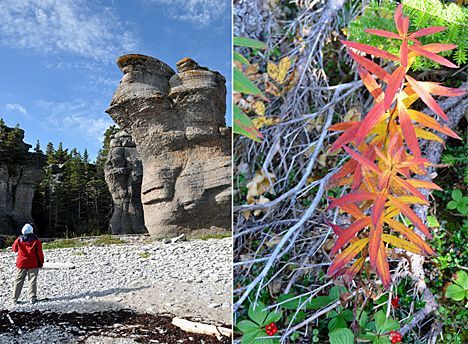
Our Parks Canada guide Andree-Anne Rouleau tells us this as she leads us from our small boat. She escorts us past one of her favorite monoliths encouraging us to look up. Then she guides us into the forest that the monoliths seem to guard like sentries. She reminds us to look down, too, and we are reminded our cruise was hailed by the Compagnie du Ponant as likely to show us fall foliage along the St. Lawrence River.
Andree-Anne continues on her way, that unusual combination of a naturalist guide who is both a great source of information and a bundle of fun. She explains what happened in this land eons ago through the last ice age.
“Now you have to come with me so I can see how observant you are,” she says.

We had been shown how the edge of a cliff looked like an old sea captain but she leads us now to some rocks and asks, “What d’you see here?” She is not satisfied until someone sees a crocodile or maybe a submarine, then a turtle or a whale, and she is captivated when we see Richard Nixon.
Before we leave this unusual island called Niapiskau with its limestone monoliths she introduces us (bottom left in the photograph) to the tall, slender and eroded Madame de Niapiskau, and the boot-shaped Monsieur de Niapiskau. She explains they two were a happy twosome until “the Scotsman” came between them. The group is still chuckling over the monolith with the Scottish headgear that really does look the part.
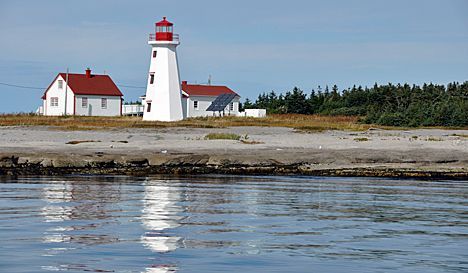
The journey back to St. Pierre takes us past the lighthouse on the little island Au Marteau, a light that is said to have saved many a ship since it was built in 1915. All those lighthouses on the north east coast of North America seem to have been created from the same blueprint even to their color schemes.
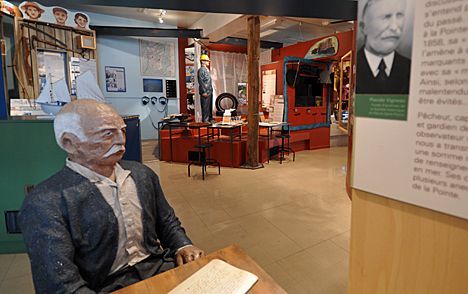
There is plenty of time back in Havre St. Pierre to visit the former Labrador and onetime Hudson Bay Company store that is now a local museum, the Cultural Center Roland-Jomphe that covers local history from 1857. The people who lived here were deported from Acadia and ended up here via the Magdalen Islands.
The museum bears the name of a St. Pierre poet who died in 2003 but the figure represented sitting at his desk is another local writer, Placide Vigneau, “a cabin boy, schooner captain and lighthouse keeper…who observed and documented the world.”

The cultural center exhibits interesting information on the attempts by the community to get a hospital. A 35-bed unit was finally built in 1930 complete with the new technology to run the lights: “a diesel engine that made the whole village shake.” The government put the Sisters of Charity in charge. By 1935 they were squeezing in 78 beds.
A 150-bed new hospital was constructed in 1942 and the nursing sisters got the former hospital as a residence. Exhibits on one wall include Old World notices that salt air would bring back health but on another wall the admission that a serious illness was often a death sentence.
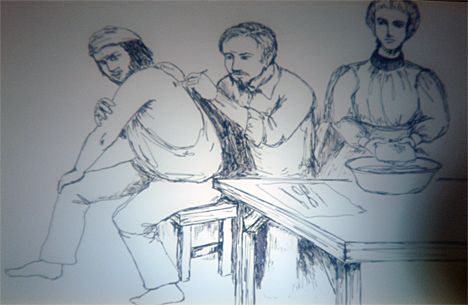
A tray of surgical instruments catches the eye and a pen and ink sketch shows some minor surgery. We are not sure which procedure the insurance company would be billed for.
The Man Who Cried Orange: Stories from a Doctor's Life.
The Andersons, who live in San Diego, are the resident travel & cruise columnists for Physician's Money Digest. Nancy is a former nursing educator, Eric a retired MD. The one-time president of the NH Academy of Family Practice, Eric is the only physician in the Society of American Travel Writers. He has also written five books, the last called




